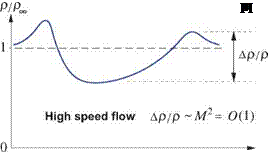Low Speed and Incompressible Flows
By considering the governing equations and definitions developed earlier, we can estimate the following typical changes д() of various quantities along a streamline, or more precisely along a particle path.
|
From ideal gas law (1.13): |
Y др ~ (7—1) (h дp + p дН) |
(1.75) |
|
From momentum equation (1.36): |
др ~ —pVдV |
(1.76) |
|
From total enthalpy definition (1.18): |
дН ~ дН0 — VдV |
(1.77) |
Eliminating др between (1.75) and (1.76), eliminating дН using (1.77), and noting that V2/h = (7—1)M2 gives the fractional density change only in terms of fractional V and ho changes.
(1.78)
A low speed flow is defined as one with a negligibly small Mach number everywhere.
M2 ^ 1 (low speed flow) (1.79)
If in addition the flow is adiabatic so that ho ~ constant and hence дН0 = 0, then (1.78) implies
 < 1
< 1
~ constant along particle path, (1.80)
 |
|
which constitutes an incompressible flow. Figure 1.13 compares typical density variations along a streamline near an airfoil in high speed and low speed flows.
Figure 1.13: In an adiabatic flow, fractional density variations др/р scale as M2 .In the low speed flow case M2 ^ 1 this implies a nearly constant p equal to the freestream value pTO.
For typical aerodynamic flows where the far-upstream density is uniform, the incompressibility result (1.80) becomes the more general statement that the density is constant everywhere in the flow, and equal to the freestream value.
p ~ constant = pTO (incompressible aerodynamic flow) (1.81)
For adiabatic low speed flow where дН0/Н ~ 0, relation (1.77) in addition indicates
 д/г h
д/г h
![]() or h constant
or h constant
so such flows are also nearly isothermal, and therefore the viscosity p is nearly constant everywhere. In this case the vector identity
|
|
|
|
|
|
|
|
together with а = V- V = 0, which is the consequence of mass conservation and p = constant, can be used to simplify the viscous momentum term in (1.34) or (1.36) to a Laplacian of the velocity.
|
|
|
|
|
|
![]()
Overall, the continuity and momentum equations simplify to the incompressible Navier Stokes equations
![]() (1.85)
(1.85)
|
|||
|
|||
|
|
||

where v = p/p is the kinematic viscosity. The energy and state equations decouple and are no longer needed.











